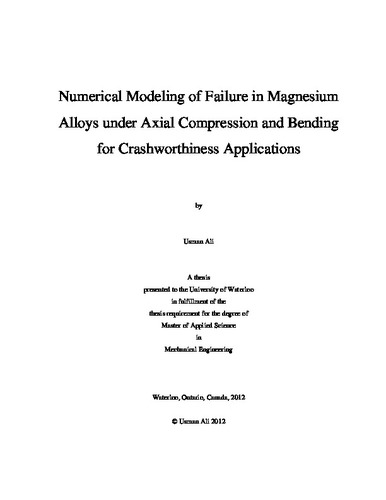| dc.description.abstract | Numerical modeling of failure was performed for magnesium alloys with circular and square cross-sections under axial compression. The failure criterion was employed using material model 124, where failure was simulated using the element deletion method. LS-DYNA material model 124 (MAT_124) was calibrated using stress-strain curves in compression and tension. This approach, combined with MAT_124, captures the material asymmetry. Comparisons with experiments showed that the failure criterion accurately predicted the stress-strain behavior during axial compression tests of the round tubes of magnesium alloy, AZ31. A parametric study was also performed to investigate the effects of various phenomena on simulated results. Numerical modeling of square magnesium tubes during bending was also simulated for extruded magnesium alloys AZ31, AM30 and AM60. The failure criterion, based on element erosion, was used in these models to simulate fracture for all three alloys. Comparisons with experiments, for all three alloys, showed that the proposed numerical model accurately predicted the force-displacement curves during bending. Engineering strain at failure was found from the tensile test curves for the three magnesium alloys (AZ31, AM30 and AM60). Simulations were done to predict local strain at the necking region at this engineering strain. The necking strain was incorporated in the failure criterion, which considerably improved results for the bending simulations. Numerical modeling of slow and fast axial compression tests were also performed for AM30, AM60 and AZ31 magnesium tubes with square cross-section. Comparisons with experiments, for all three alloys, showed that the proposed numerical model accurately predicted the force-displacement curves during quasi-static and high-speed crush tests. Furthermore, the predicted fracture locations and patterns were in good agreement with experimental observations. Finally, new failure criteria was employed to improve the crashworthiness behavior of magnesium alloys by several tube design variations. Magnesium tubes cladded with aluminum and magnesium tubes with alternating strips of aluminum were simulated. Magnesium tubes with thinned sections and spirals were also simulated. Results showed that most of the design modifications increased the crashworthiness of magnesium alloys tubes. | en |

